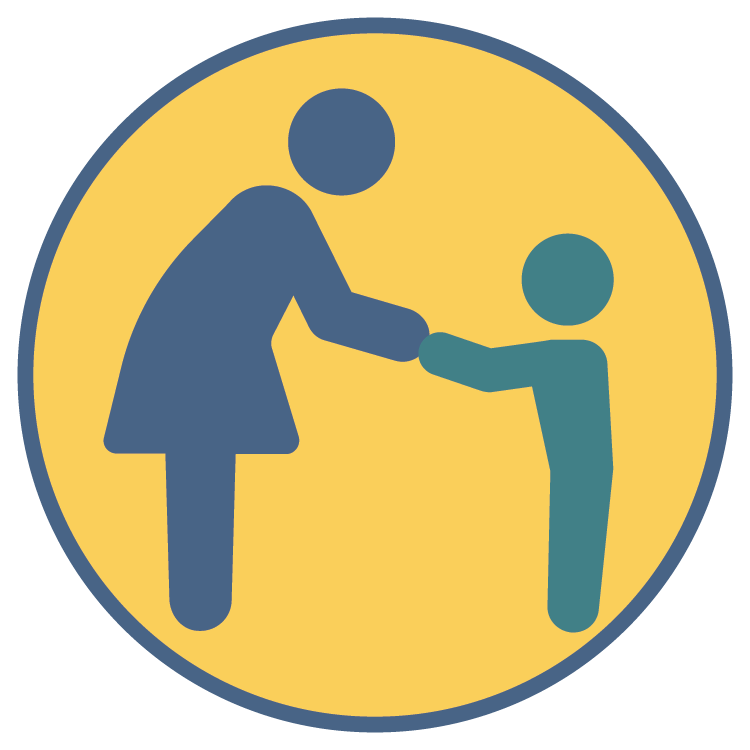Lesson 1 - Communication Essentials
In this lesson, you’ll meet a number of children who are deafblind and learn how they communicate. You’ll examine the foundations for supporting communication for any child who is deafblind and ways of assessing their communication. And you’ll understand why an individualized, formal communication plan is essential.
For more information, visit the National Center on Deafblindness at nationaldb.org.

Learning Objectives
Lesson 1 has three learning objectives. After completing the lesson, participants should be able to
- Describe the variety of ways children who are deafblind expressively and receptively communicate
- Identify key features of communication assessment for children who are deafblind
- Explain the importance of a having a formal communication plan for a child who is deafblind and what should be included
Topics Covered
- What communication looks like for children who are deafblind
- The Communication Bill of Rights
- Types of expressive and receptive communication
- Modes, or forms, of communication
- The importance of developing a system of communication
- Communicating with multiple communication partners
Activities
Instructors: The following activities can be adapted for a variety of purposes. For example, have participants turn in written or posted responses, or use the topics and questions as discussion starters. Some can also be used for group activities.
Option 1
Read the “Communication Bill of Rights,” created by the National Joint Committee for the Communication Needs of Persons With Severe Disabilities. Which two rights do you feel are particularly important for children who are deafblind and why?
Option 2
Watch this short video of Brielle, a child who is deafblind, and her cousin Robin. You’ll hear Brielle’s mom talking in the background. How would you describe Brielle’s receptive communication? How would you describe her expressive communication?
Option 3
Part 1 of this lesson addressed both expressive and receptive communication. What is the difference between these types of communication? Include in your response examples of how a child who is deafblind might communicate expressively and receptively.
Part 2 - Communication Assessment
Topics Covered
- Different methods of assessment for children who are deafblind
- Conducting an initial assessment of a child’s communication
- Levels of communication and their characteristics
- The Communication Matrix and the Holistic Communication Profile
- The importance of ongoing assessment
Activities
Instructors: The following activities can be adapted for a variety of purposes. For example, have participants turn in written or posted responses, or use the topics and questions as discussion starters. Some can be used for group activities.
Option 1
What are the main differences between how a child communicates at Level 3 and Level 4? Provide examples of how children who are deafblind might express something at each of these levels.
Option 2
Watch this short video of Brielle. What do you think her level of communication is, and what are the characteristics of a child who communicates at this level?
Option 3
Visit the Communication Matrix website and complete a practice assessment for a child. From the homepage, scroll down to the Assessment section, and select the “Try It” link to get started.
Part 3 - The Communication Plan
Topics Covered
- The importance of a formal communication plan
- What the plan should include
- How it should be implemented
- Involving the family
- Helpful documents and materials
- Keeping the plan up to date
Activities
Instructors: The following activities can be adapted for a variety of purposes. For example, have participants turn in written or posted responses, or use the topics and questions as discussion starters. Some can be used for group activities.
Option 1
Respond to the following questions:
- What is the importance of a communication plan for a child who is deafblind?
- What types of information should be included in an effective plan?
- Who is involved in creating the plan?
Option 2
Closely watch these two short videos, which show an adult using a touch cue with a child who is deafblind.
Determine what each touch cue is and what it means. Then, create a Touch Cue Map for each child that could be included in their communication plan to explain the cue to those who will interact with the child.
Quiz
Instructors are welcome to use this quiz as-is or adapt it to meet their needs. It can be used to test participants’ knowledge following completion of the module or for pre- and post-test evaluation. To obtain answers to the quiz, instructors should contact support@nationaldb.org.
Additional Resources
Communication Bill of Rights
Fundamental rights that should be ensured in all interactions and interventions with persons who have severe disabilities (developed by the National Joint Committee for the Communication Needs of Persons with Severe Disabilities)
NCDB Info Topic: Communication and Learning Assessments
Resources that describe how to assess communication and learning for children who are deafblind and how these two areas of assessment overlap
NCDB Info Topic: What is Communication?
Introductory information on the meaning of communication and how it is much broader than spoken or signed language
NCDB Info Topic: Overview of Communication Methods
Information about the wide variety of methods—also called modes or forms—of communication used by children who are deafblind
How Can I Help My Child Understand What is About to Happen
How to use touch cues and other cues to help a child understand a message (a fact sheet from the Nevada Dual Sensory Impairment Project)
Communication Plan for a Child Who is Deaf or Hard of Hearing (Annotated) - School Age
This communication plan was developed for IEP teams in Pennsylvania to use for children who are deaf or hard of hearing, including those who are deafblind (developed by the Pennsylvania Training and Technical Assistance Network)
